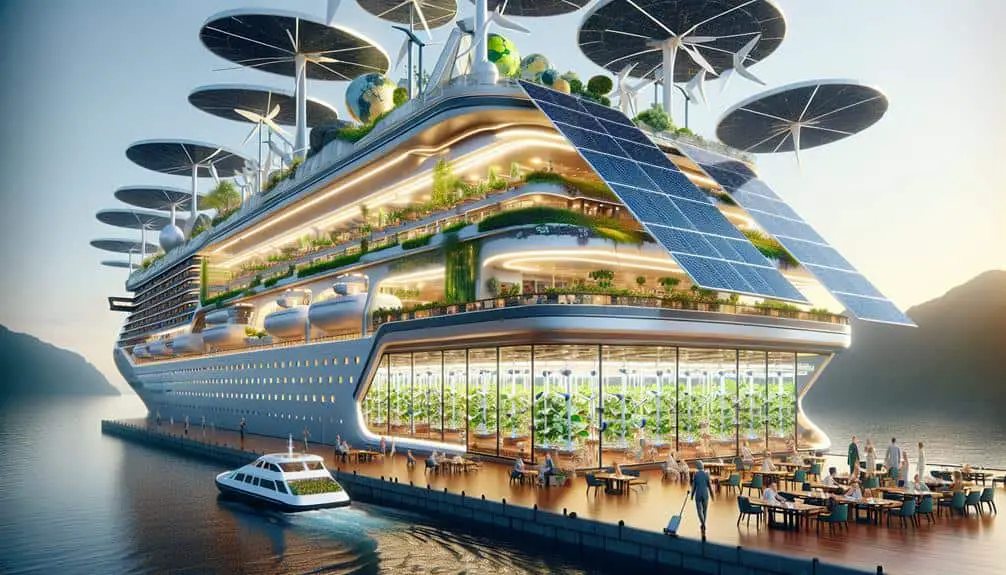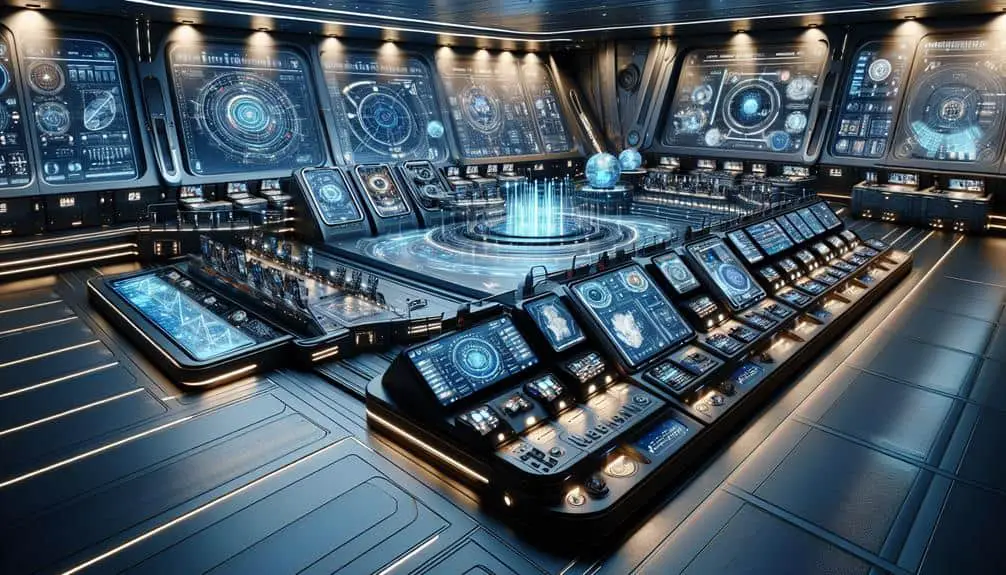To promote sustainability in cruise ship design, embrace advanced technologies. Utilize LNG engines for fuel efficiency. Implement scrubbers to reduce emissions. Manage waste with composting and recycling systems. Choose eco-friendly materials like recycled steel and bamboo. Embrace water conservation through rainwater harvesting and greywater recycling. Integrate green energy sources such as solar panels and wind turbines. These innovations set new standards for sustainability at sea.
Key Points
- Utilize LNG engines and scrubbers for cleaner emissions and enhanced fuel efficiency.
- Implement advanced waste management systems for composting and recycling.
- Choose eco-friendly materials like recycled steel and responsibly sourced wood.
- Incorporate water conservation technologies like rainwater harvesting and greywater recycling.
- Integrate renewable energy sources such as solar panels and wind turbines for reduced fossil fuel dependency.
Energy-Efficient Propulsion Systems
Have you ever wondered how energy-efficient propulsion systems are revolutionizing cruise ship design? Fuel efficiency and emissions reduction are at the forefront of this innovation. By incorporating advanced propulsion technologies such as LNG engines, scrubbers, and hybrid systems, cruise ships can greatly reduce their environmental impact while enhancing operational efficiency.
Fuel efficiency plays a critical role in the sustainability of cruise ships. Advanced propulsion systems optimize fuel consumption, resulting in cost savings for cruise lines and reduced emissions harmful to the environment. LNG engines, for example, burn cleaner than traditional marine fuels, leading to a substantial decrease in sulfur oxide and particulate matter emissions.
Moreover, emissions reduction is a key focus in modern cruise ship design. Scrubbers help eliminate harmful pollutants from exhaust gases, ensuring compliance with stringent environmental regulations. Hybrid propulsion systems further enhance sustainability by utilizing a combination of power sources, such as batteries and conventional fuels, to minimize emissions during port operations. Embracing energy-efficient propulsion systems isn't only an important advancement but also a vital step towards a greener future for the cruise industry.
Waste Management Solutions
Efficient waste management solutions play an important role in enhancing sustainability practices within the cruise ship industry. To achieve this, cruise ships are implementing advanced composting systems and innovative recycling initiatives. Composting systems onboard help convert organic waste into valuable compost, reducing the volume of waste sent to landfills. Recycling initiatives focus on segregating waste streams and processing materials like plastics, glass, and metals for reuse. Waste reduction strategies such as source reduction and efficient packaging also contribute to minimizing overall waste generation.
Circular economy approaches are being adopted to guarantee that waste materials are reintegrated into the production cycle whenever possible. By implementing closed-loop systems, cruise ships aim to maximize the value extracted from waste streams and minimize environmental impact. These initiatives not only reduce operational costs but also demonstrate a commitment to environmental stewardship. Cruise ships that prioritize waste management solutions are moving towards a more sustainable future, setting a new standard for responsible maritime practices.
Eco-Friendly Materials Selection
In the domain of cruise ship design, the selection of eco-friendly materials plays a pivotal role in advancing sustainability objectives. When considering eco-friendly materials for cruise ship construction, utilizing recycled materials is a key practice. Incorporating recycled steel, aluminum, glass, and plastics not only reduces the demand for virgin resources but also minimizes the environmental impact associated with extracting and processing raw materials.
Sustainable practices in materials selection extend beyond just using recycled materials. Opting for renewable resources like bamboo, cork, or responsibly sourced wood can further enhance the eco-friendliness of cruise ship components. These materials not only have a lower carbon footprint but also promote biodiversity and support sustainable forestry practices.
Moreover, eco-friendly coatings and finishes can be applied to surfaces to reduce emissions of volatile organic compounds (VOCs) and minimize environmental harm. By adhering to sustainable practices in materials selection, cruise ship designers can notably contribute to the overall sustainability of the maritime industry.
Water Conservation Technologies
Water-saving technologies integrated into cruise ship systems greatly enhance onboard sustainability and efficiency. Rainwater harvesting systems collect and store rainwater for various non-potable uses, reducing the demand for freshwater intake. This collected water can be utilized for activities like deck washing, laundry, and irrigation, lessening the strain on the ship's freshwater reserves.
Greywater recycling systems treat wastewater from sinks, showers, and laundry facilities to remove impurities, allowing the water to be reused for tasks that don't require potable water. By recycling greywater onboard, cruise ships can markedly decrease their overall water consumption and minimize the volume of wastewater discharged into the ocean.
Integrating these advanced water conservation technologies not only promotes environmental stewardship but also enhances operational efficiency. Cruise ships that prioritize rainwater harvesting and greywater recycling contribute to sustainable practices while ensuring a more self-sufficient and eco-friendly operation.
Green Energy Integration
Utilizing cutting-edge renewable energy sources is paramount in enhancing the sustainability and efficiency of cruise ship operations. Incorporating renewable energy sources like solar panels and wind turbines can greatly reduce the reliance on traditional fossil fuels, thereby decreasing greenhouse gas emissions and overall environmental impact. These sources can be integrated into various parts of the ship, such as the top deck for solar panels and strategically positioned areas for wind turbines.
Moreover, energy storage solutions play an important role in ensuring a consistent power supply on cruise ships. Advanced battery systems, such as lithium-ion batteries, can store excess energy generated from renewable sources during peak production times and provide power during periods of low production or high demand. This aids in balancing energy loads and optimizing the efficiency of the ship's energy distribution system.
Frequently Asked Questions
How Do Cruise Ships Handle Food Waste Disposal and Recycling on Board?
When it comes to handling food waste disposal and recycling on board, cruise ships have sophisticated waste management systems akin to a well-oiled machine. Utilizing composting, recycling programs, and food donations are integral to sustainability efforts.
Are There Any Initiatives in Place to Reduce Air Pollution Emissions From Cruise Ships?
To reduce air pollution emissions from cruise ships, initiatives have been implemented. These include utilizing alternative fuels to meet strict emissions standards, integrating advanced technology for enhanced energy efficiency. Continuous advancements aim to minimize environmental impact and promote sustainability.
What Measures Are Taken to Protect Marine Life and Ecosystems During Cruise Ship Operations?
To protect marine life and ecosystems during cruise ship operations, various measures are implemented. These include marine conservation efforts, sustainable practices, biodiversity protection, and eco-friendly operations. Such initiatives aim to minimize environmental impact and promote responsible tourism.
How Do Cruise Ships Manage and Treat Wastewater Generated on Board?
Innovative water treatment systems on cruise ships efficiently manage wastewater, impacting the environment positively. By recycling greywater and prioritizing energy efficiency, vessels minimize their ecological footprint, demonstrating a commitment to sustainability in maritime operations.
What Steps Are Being Taken to Reduce the Use of Single-Use Plastics on Cruise Ships?
To reduce single-use plastics on cruise ships, consider implementing reusable alternatives like stainless steel straws and refillable water bottles. Waste reduction initiatives include onboard recycling programs and encouraging passengers to minimize plastic consumption through educational campaigns.




